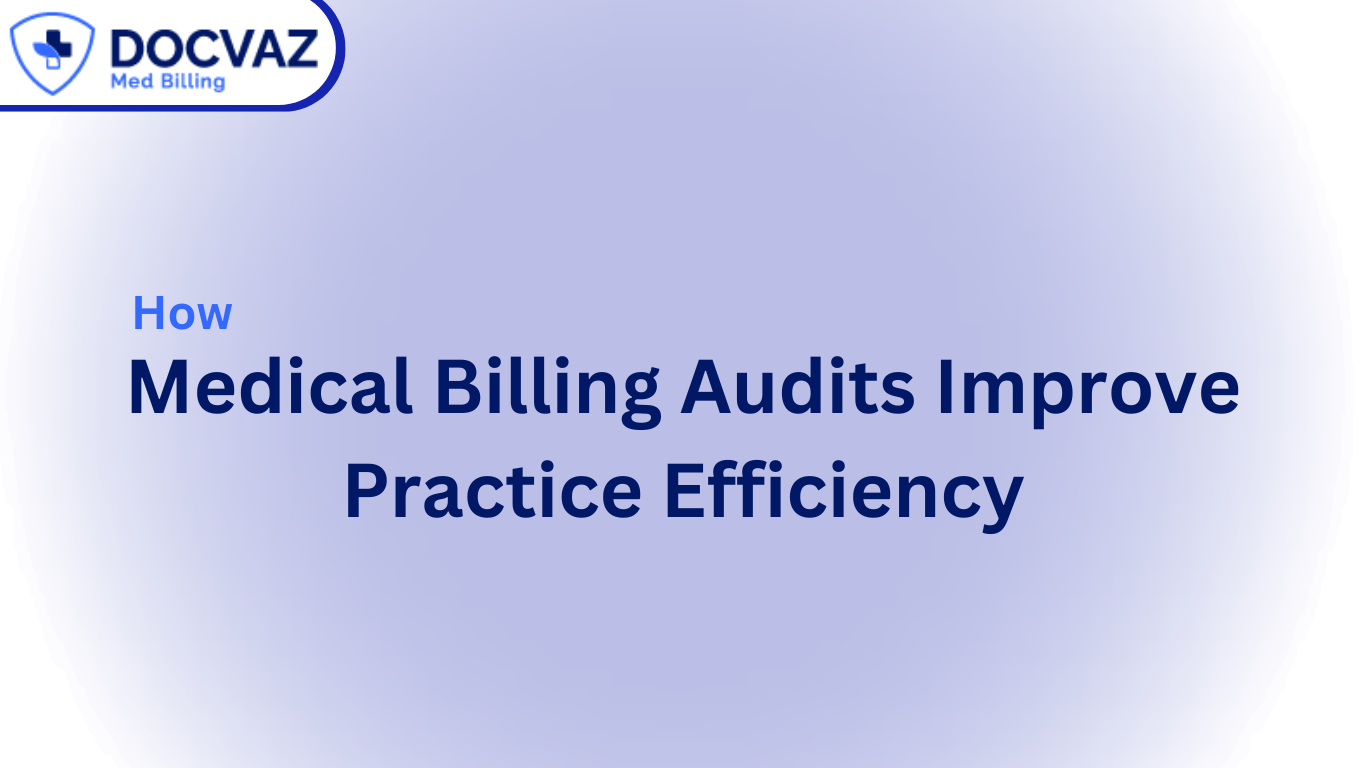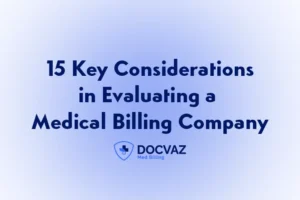A medical billing audit is like a check-up—but instead of looking at a patient’s health, it looks at a clinic or hospital’s billing records to make sure everything is being done correctly. This includes checking if the right codes are being used for services, if all the paperwork is in place, and if insurance claims are being handled properly.
These audits are really important because they help catch mistakes, avoid problems with insurance companies, and make sure the clinic is getting paid the right amount for the care they provide.
The goal of this article is to explain how billing audits help clinics and doctors’ offices work better and faster, save money, and take better care of their patients by improving how their billing systems run.
What is a Medical Billing Audit?
A medical billing audit is a process where healthcare providers check and review their billing practices to ensure everything is correct. It involves looking at medical codes, billing records, and insurance claims to make sure they match the services provided to the patient.
Difference Between Internal and External Audits
Internal Audits: These audits are done within the practice. Staff or a dedicated audit team at the healthcare facility will review the billing records to find any errors or areas for improvement. Internal audits are usually done regularly and focus on the practice’s own billing system.
External Audits: These are audits done by outside organizations or government agencies. Insurance companies or government health programs may perform these audits to ensure the practice is following the correct rules and regulations for billing.
How Audits Fit Into the Revenue Cycle of a Medical Practice
A revenue cycle is the process of managing a practice’s money—from when a patient visits for a service until the bill is paid. Medical billing audits play a key role in this process by:
Checking for errors: Audits help identify mistakes in coding or billing, reducing the chance of claim denials and ensuring the practice gets paid properly.
Improving efficiency: By catching errors early, audits help the practice streamline its billing system, saving time and effort.
Ensuring compliance: Audits ensure the practice follows all the correct rules and guidelines, avoiding penalties or legal issues.
Common Billing Issues Found in Audits
When medical billing audits are conducted, certain issues often come up. Here are some common ones:
Coding Mistakes:
- Example: Using the wrong code for a service or procedure, such as a code for a simple office visit when a more complicated procedure was done.
- Impact: This can lead to underpayment (not getting enough money for the service) or overpayment (getting too much money, which can lead to fines or having to pay it back).
Missing Documentation:
- Example: Failing to provide proof of the service that was billed for, like missing notes in the patient’s file that show what treatment was given.
- Impact: This can delay payments, cause claims to be denied, or create confusion when insurance companies need to review the case.
Duplicate Charges:
- Example: Charging for the same service more than once, either by mistake or because the billing staff didn’t catch it.
- Impact: This can lead to patients being overcharged, or the practice receiving too much payment and needing to refund the extra amount.
How These Issues Affect Practice Revenue and Efficiency
Revenue Impact:
- Mistakes like coding errors or duplicate charges can directly affect how much money a practice gets. For example, if the practice is underpaid because of a coding error, they lose revenue. If they’re overpaid, they may face refunds or audits from insurance companies.
Efficiency Impact:
- When these issues are found, it means the practice has to spend extra time fixing them, which slows down the billing process. Staff may need to rework claims, deal with insurance disputes, or even chase after payments, all of which takes time away from seeing patients or focusing on other important tasks.
The Cost of Ignoring These Problems Over Time
If billing problems are ignored, they can cause bigger issues down the line. The cost of not catching mistakes early includes:
- Lost Revenue: Not getting properly paid for services provided.
- Increased Denials: More insurance claims being rejected due to mistakes.
- Legal or Regulatory Issues: Non-compliance with billing regulations could lead to fines or penalties.
- Wasted Time: Staff spend more time fixing old mistakes rather than working efficiently.
Ways Audits Improve Efficiency
Medical billing audits play a crucial role in enhancing the efficiency of a medical practice. Here’s how audits help improve various aspects of practice management:
1. Identify and Fix Billing Errors
Reducing Claim Denials and Delays:
- Billing audits help catch errors like incorrect codes or missing information before claims are submitted. By identifying mistakes early on, the practice avoids denials and delays that can occur during the insurance review process.
Ensuring Quicker Payments and Fewer Corrections:
- When errors are fixed before submission, there are fewer corrections needed later. This streamlines the entire billing process, allowing for faster reimbursements and less back-and-forth with insurance companies.
2. Improve Coding Accuracy
Helps Coders and Staff Use the Correct Codes:
- Medical coding audits ensure that coders use the correct codes for procedures and diagnoses. This helps prevent billing for the wrong service or procedure, reducing claim rejections and ensuring compliance with regulations.
Minimizes Undercoding or Overcoding Risks:
- Audits help catch undercoding (where codes are used too conservatively, leading to lower reimbursement) and overcoding (where codes are used incorrectly to maximize reimbursement). By ensuring accurate coding, audits help practices receive the correct amount of payment for services provided.
3. Streamline Workflow
Audits Show Where Billing Processes Slow Down:
- By reviewing the entire billing cycle, audits identify bottlenecks and inefficiencies in the process. This can highlight areas where practices need to make changes, like improving the flow of information between departments or streamlining administrative tasks.
Helps Practices Create Faster and Simpler Billing Routines:
- Once problem areas are identified, practices can implement new strategies and processes that reduce delays and complexity, leading to faster billing and smoother workflows.
4. Boost Staff Performance
Reveals Training Needs:
- Audits highlight areas where staff may need further training, whether it’s understanding the latest coding updates, handling complex claims, or using billing software more efficiently. Addressing these gaps improves the overall skill level of the team.
Encourages Better Communication Between Staff and Billing Teams:
- Audits foster a culture of collaboration and open communication. By identifying errors that may stem from miscommunication, practices can improve coordination between clinical and billing staff, leading to fewer mistakes and a more efficient process.
5. Enhance Cash Flow
More Accurate Claims = Faster Reimbursements:
- When claims are coded and billed accurately, insurance companies are more likely to approve them quickly. Fewer mistakes mean fewer delays, which results in faster payments and improved cash flow.
Less Time Spent Fixing Mistakes = More Focus on Patient Care:
- By reducing the time spent on fixing errors, staff can focus more on patient care and other important practice functions. This ensures that the practice runs more efficiently and that patient satisfaction remains high.
Tools and Technology that Support Audits
The right tools and technology can greatly enhance the accuracy, efficiency, and effectiveness of medical billing audits. Here are some of the key tools and technologies that support audits:
1. Audit Software and Automated Billing Tools
Audit Software:
- Specialized audit software allows practices to track and identify errors quickly, ensuring that claims are accurate before submission. These tools can automatically check for common mistakes such as incorrect codes, missing data, and billing inconsistencies.
Automated Billing Tools:
- Automated billing tools streamline the entire billing process, from claim creation to payment processing. These tools reduce human error, speed up the submission process, and help practices stay on top of payment cycles.
2. Benefits of Using Electronic Health Records (EHR)
Improved Documentation:
- EHR systems allow for better documentation and organization of patient information. This makes it easier for billing staff to access complete medical records, ensuring that accurate codes are assigned.
Integrated Systems:
- With integrated EHR systems, coding and billing teams can directly access patient data, diagnoses, treatment plans, and procedure details without needing to manually cross-reference paper records. This leads to fewer errors and more accurate billing.
Time-saving:
- EHR systems save time by eliminating the need for paper documentation and reducing the chance of missing or misplaced information, speeding up the audit process.
3. Importance of Real-Time Reporting Dashboards
Instant Access to Key Data:
- Real-time reporting dashboards allow practices to monitor key performance indicators (KPIs) such as claim denials, rejection rates, and payment cycles in real-time. This helps identify issues quickly so that they can be addressed before they escalate.
Data-driven Insights:
- Dashboards provide actionable insights based on up-to-date data, allowing practices to adjust their workflows, improve billing accuracy, and address inefficiencies on the spot. By making data visible and accessible, practices can make more informed decisions during the audit process.
Best Practices for Conducting Audits
Conducting thorough and effective audits requires adopting best practices that ensure audits are systematic, timely, and produce valuable insights. Here are some best practices to follow:
1. Schedule Regular Audits (Monthly, Quarterly, etc.)
Consistency in Auditing:
- Regular audits, whether monthly or quarterly, help keep coding and billing practices on track. Frequent audits allow teams to identify patterns of mistakes and address issues before they affect revenue. By making audits part of the regular workflow, practices can maintain high standards of accuracy.
Scheduled Audits:
- Scheduled audits should be planned in advance and incorporated into the practice’s calendar. They should not be left to chance or performed only when errors occur. This proactive approach keeps the practice’s billing and coding up to date and efficient.
2. Hire Qualified Coding and Billing Professionals
Expertise Matters:
- Hiring qualified coding and billing professionals is essential for accurate audits. These professionals should be knowledgeable about the latest codes, regulations, and insurance policies to ensure that audits are comprehensive and correct.
Ongoing Training:
- It’s important to provide ongoing training to coding and billing staff. Keeping up with changes in medical codes, insurance regulations, and billing procedures is essential for ensuring accuracy and preventing errors.
3. Keep Clear Documentation and Open Communication
Accurate Documentation:
- Documentation is key during audits. Ensure that all coding and billing decisions are well-documented so that audits can be performed efficiently. This includes keeping detailed records of patient care, codes assigned, and the reasoning behind billing decisions.
Open Communication:
- Effective communication between billing and coding teams, as well as with healthcare providers, is crucial. Open communication helps clarify coding decisions and ensures that everyone is on the same page, reducing errors and miscommunications during the audit process.
Conclusion
Medical billing audits play a crucial role in boosting billing accuracy and enhancing the overall efficiency of healthcare practices. By identifying and rectifying errors such as coding mistakes, documentation gaps, and duplicate charges, audits help ensure that claims are accurate and processed quickly. This, in turn, leads to fewer claim denials, faster reimbursements, and a more streamlined billing process.
Incorporating audits into regular practice operations not only improves billing accuracy but also optimizes staff performance, improves cash flow, and enhances overall practice management. Practices that make audits a consistent part of their workflow will be better equipped to handle billing complexities and maintain financial health over the long term.
By adopting a proactive auditing approach, healthcare providers can safeguard against revenue losses, improve operational efficiency, and ensure a smoother experience for both their staff and patients. Regular audits are not just about detecting errors—they are an investment in the future success of the practice.




